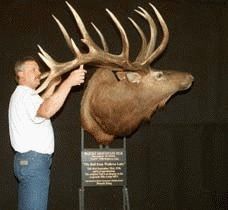LEGENDARY HERD
Published 12:00 am Friday, October 29, 2004

- David Morris, editor of the Record Book for Oregon's Big Game Animals, examines a reproduction of Taft in 1999 in Baker City. Taft was one of the elk brought in from Wyoming in 1912 to help revive Northeast Oregon's elk population. (Observer file photo).
By Dick Mason
Staff Writer
It is a transplant that spawned a myth that may outlive tales of the Wallowa Lake monsters.
Turn the calendar back to March 1912.
Fifteen elk were being transported by train from Wyoming to a place where they were considered virtually extinct Northeast Oregon.
It was as if the Liberty Bell were being brought in from Philadelphia. Thousands of people gathered in some towns to see the elk at train stations. In La Grande, for example, 3,000 people came to see the elk on March 14, 1912, according to an article in The Observer.
The train was later greeted by large crowds in Elgin, Lostine and Enterprise before reaching Joseph. The animals were then taken by horse-drawn wagon to Billy Meadows, 46 miles north of Joseph. There the elk were placed in a 2,560-acre enclosure owned by the Oregon State Game Commission, according to the May 16, 1912, edition of the Wallowa County Chieftain.
This herd had a future legend Taft a dominant bull and one of the highest ranked in Oregon’s history. Taft would live until 1930 before succumbing to injuries suffered in a fight with another bull. Taft’s antlers were scored at a remarkable 391 4/8 points.
The transplant was completed in 1913 when 15 more elk from Wyoming were brought to Wallowa County.
MYth versus reality
Today a myth still emanates from the transplant. Some people insist that all of the elk in Northeast Oregon are descendants of the 30 elk brought here in 1912 and 1913.
This can’t be so. Elk were rare in Northeast Oregon. But they were not extinct when the state banned elk hunting in 1905.
This explains why a dozen years after the transplant, elk were becoming a nuisance and causing property damage in Wallowa County. By 1933 there were enough elk that a hunting season in Northeast Oregon opened.
The quick increase from 1912 to 1933 indicates that other elk were present in addition to those from the Wyoming transplant.
andamp;quot;There certainly were not enough (elk from Wyoming) to explain the increase following the transplant,” said Oregon Department of Fish and Wildlife biologist Mark Henjum.
Sure, elk were rare in Northeast Oregon in the early 1900s. But there were more here than people realized. Henjum explained that elk were probably in remote roadless areas that were much harder for people to get to in those days.
It is also important to understand that elk are elusive; thus, they are often more abundant than people realize.
andamp;quot;Elk have an ability to escape people,” Henjum said.
An elk management report prepared by the ODFW confirms that there more elk in Northeast Oregon 90 years ago than people realized.
andamp;quot;The scale of transplanting in the early 1900s was limited and does not account for the rapid increases in elk numbers and distribution. Recovery of elk in Oregon and elk expansion into much of their original range is largely the result of total protection of local remnant populations,” the report states.
Hot Lake elk
When settlers first came here in the 1800s, elk were apparently plentiful in Northeast Oregon. Documentation of this dates to Aug. 7, 1812. This was the day that explorer Robert Stuart and his companions visited Hot Lake while traveling from Astoria to St. Louis. American author Washington Irving (1783-1859) wrote about what Stuart saw in his book andamp;quot;Astoria.”
andamp;quot;The place was much frequented by elk, which were found in considerable numbers in the adjacent mountains, and their horns, shed in the springtime, were strewed in every direction around the pond,” wrote Irving, who is best known for his stories andamp;quot;Rip Van Winkleandamp;quot; and andamp;quot;The Legend of Sleepy Hollow.”
Elk were also abundant then in other parts of Oregon. The journals of Lewis and Clark indicate that the members of its party consumed large qualities of elk meat on the Oregon Coast during the winter of 1804-05.
Elk populations, however, began to decline as the Northwest was settled.
andamp;quot;Settlers hunted elk as a primary source of meat,andamp;quot; the ODFW report states, andamp;quot;and harvests were unregulated. In the last half of the 19th century, ‘market hunting’ and human encroachment on elk range took a heavy toll on Oregon’s elk populations.”
The report notes that market hunters killed thousands of elk for meat, hides and antlers. These were sold in Oregon and shipped throughout the nation.
By the late 1800s, elk numbers had plummeted in Northeast Oregon and throughout Oregon.
andamp;quot;Reports of elk scarcity became common during the late 1880s,andamp;quot; the ODFW report says. andamp;quot;Elk populations were reduced to only a few small herds along the coast, in the Cascades and the Northeast Oregon.”
The Oregon Legislature first provided protection for elk in 1899 by making it illegal to sell meat from wild animals.
In 1904, hunting restrictions were first imposed to protect elk. That year only one bull could be killed per hunter between Sept. 15 and Oct. 15. In 1905 all elk hunting in Oregon was banned, according to the book andamp;quot;Elk of North Americaandamp;quot; edited by Jack Ward Thomas and Dale Toweill.
By 1922, elk numbers has increased greatly in Wallowa, Umatilla, Baker, Union, Grant, Clatsop and Tillamook counties, according to the ODFW’s management report.
However, by 1924 the state was receiving numerous landowners complaints about elk. Elk hunting was thus reestablished in Eastern Oregon in 1933 and in Western Oregon in 1938.
This year’s bull elk rifle season started on Wednesday in Northeast Oregon. Some of the elk taken may be descendants from the Wyoming transplant of 1912 and 1913, but the odds are greater that the elk have true Oregon roots.





